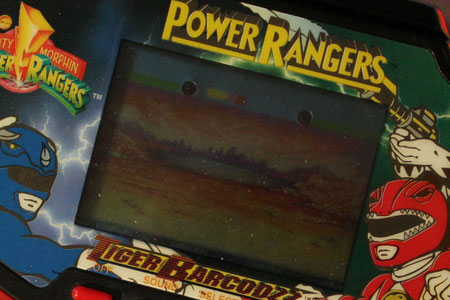The 1980s and 90s were a golden age of licensing cool kid junk. If it was a TV show for kids, you’d be able to find everything from video games to underoos based on that property. There were Bump in the Night action figures, pogs, and Carl’s Jr. pencil toppers, and nobody even remembers what that show was. But it got even weirder: your Beetlejuice Happy Meal toys were from a cartoon based on a movie where a teenager is nearly forced into an arranged marriage with a pervert undead apparition who drops the f-bomb. And in the late 80s, you could play The Real Ghostbusters on your Game Boy while wearing your Stay Puft digital watch, all from a cartoon based on a movie where someone gets a BJ from a ghost. Nothing was really off limits. Let’s not even talk about Robocop.
But it was great. Being actively sold toys and games of the things you watched on TV might feel icky, especially when those things are being promoted to kids who have little agency in their own financial situations and what they perceive as needs, but it’s something we’ve all experienced. Our grandparents had to deal with it too, as far back as the days of decoder rings on the radio, and they turned out okay. Maybe it’s not all as terrible as it seems on the surface. Being able to interact with the fictional worlds that you love is an integral experience for the imagination, despite the outdated idea that exposure to TV limits creativity. Help a kid develop the creative tools to interact with media and fiction, and they’ll soon be creating their own worlds based on that framework.
One of the world-types that started emerging strongly in the ’90s was the strange universe of lycra-suited Japanese hero teams and giant rubber monsters — heavily Americanized, of course. And like anything else, there were hundreds of ways to immerse yourself in those worlds.
The Mighty Morphin’ Power Rangers blazed a trail that opened the way for the Big Bad Beetleborgs, VR Troopers, and the Superhuman Samurai Syber-Squad… for better or worse. Just throw a whole bunch of teenagers into a super team, intercut it with overdubbed footage from Japanese shows, and you were set. Most of these had action figures, wearable costume parts and weapons, and the occasional figural bubble bath bottle. But if you were a giga-nerd, you probably were really into the games based on these series… and there were a lot of really bad ones.

Barcodzz was a pretty novel concept by Tiger Electronics. Do you like bad video games and supermarket checkout lines? Take the usual terrible LCD games of the 80s, but update them with exciting barcode technology! Scanning barcodes was a concept that a few companies played with in the 90s, as the technology became cheaper and more portable. The result was competition in the US from handheld systems like Skannerz and Barcode Battler, all of which enabled you to scan various barcodes into their respective games for different effects. Some of these games came with a standard set of useable barcodes, while others encouraged you to scan all of the barcoded items in your house until you generated an effect you really liked. The latter was the case with Skannerz, which saw kids cutting up cereal boxes, action figure packaging, and anything else that bore a series of scannable lines; I’ll get into Skannerz in more detail in the future. Because random barcodes couldn’t be interpreted easily, discovering hidden codes out in your own real universe, using them to generate random effects, and then cataloguing them, was very exciting.
Barcodzz was a little more standardized. The Barcodzz line included five different licensed games : Mighty Morphin’ Power Rangers, X-Men, Mortal Kombat, Super Street Fighter II, and The Adventures of Batman & Robin. These played like any other LCD game : you play a figure with a very limited set of moves and animations displayed in dark grey on a light grey screen, manipulated by some very delayed controls, and only a vague sense that you knew what was going on. Even on a good day, the games were kinda hard to interpret. Except now, in addition to trying to comprehend the actions on the screen, you could scan a set of barcoded cards that came with the game through a slot at the top of the device to summon different characters and attacks. It’s all the fun of trying to pay for something with a wonky credit card.
Today, it can be pretty difficult to actually find one of these devices complete with all of the necessary cards to play the game, especially if you’re a Batman fan. It’s almost worth it to try to figure out the whole overcomplicated, unplayable mess that these are, and to feel the sheer disappointment the kids of the 90s felt when trying to wrap their brains around how they could be betrayed by a simple video game… this time even worse than Spot for the NES, one of the most crushing birthday presents of all time.
Finding a manual for Power Rangers wasn’t possible, but I was able to interpret an X-Men manual into how the system works, in a general sense. If you don’t have a manual, you’re pretty much screwed.
There are three game modes. Mode 1 can be played without cards as a standard LCD game, and that pretty much explains itself. Mode 2 uses the barcodes in a 1-player game, and Mode 3 is a 2-player version of Mode 2. Before you play, you must select one of these modes. Without instructions, it’s not easy to understand which is which.
Mode 2 is strange in that your barcoded cards don’t have any expected effects. Before each round, you scan some cards – barcode facing you, from left to right (no matter what the commercials for this look like they’re doing). You’ll get a confirmation noise when the scan works, but the sensor is pretty finicky. It makes a huge difference when you dust the sensor, so gGet in there with some air and/or a brush with long, soft bristles. I thought my Barcodzz was busted until I gave it a good cleaning.
You don’t choose a set of cards that has the most desirable effects; instead, you seem to have to choose them randomly. Scanning the Megazord card will not give you a Megazord. Sometimes, a random card can make the boss weaker or stronger, but other times you’ll get a fellow Power Ranger to join you and automatically fight the bad guys. Sometimes, you will get the full Megazord on your side as the result of a random scan. The why of this isn’t really explained, and it’s not super clear how any of this really helps you. The Megazord just seems to stand in one place and flail its arms anyhow.
It’s all a cool gimmick, and a neat little experimental artifact from the licensed weirdness section of games, but nobody is going to be speedrunning this thing anytime soon. It’s awful, but if you want to see how your parents suffered in the 90s, here’s implement of torture number one. For lesson two, try a dial-up modem for a day.

For kids who liked their games a little more visceral, and their Power Rangers a little more off-brand, there was the simply titled VR Troopers Game. With a cassette deck, a set of cards, and some paper glasses with red-tinted lenses, you could have a whole half hour of fun. The gimmick here is pretty interesting, too : the cards would be laid out on a table, but the cards’ effects would be obscured by a red pattern called a “Reality Barrier” that was rendered more or less invisible when you put on those special glasses, which are a cheap version of a similar device used in the show. As you listened to the tape, it would instruct you in a series of steps, from setup, to when you should pause, and when you should be wearing the decoder glasses.
It sounds a little complicated, so I made an instructional video using this tape and examples of these cards.
Could you see the secret symbols without the magic glasses? Well, yeah. It’s pretty hard to play this game without cheating, and ‘cheating’ in this instance is just ‘looking’. The game’s narrator sounds vaguely like Rene Auberjonois, and it’s a level of interactivity and immersion that’s actually pretty cool in theory. Today, this would probably be done with QR codes and augmented reality apps, but in the days before kids had fancy stuff like Internet and mp3s, this was pretty much high tech.
Even more complex versions of this general concept included VHS games like Nightmare, Star Wars, Star Trek, and even Isaac Asimov’s Robots, which all were generally incomprehensible when we tried to play them as kids at sleepovers in the 90s, when everyone was far more interested in gathering around the Super Nintendo. There was always a lot of competition for attention between traditional games, no matter how innovative, and video games; these often lost in the noise, but it’s cool that people were attempting something different, even for just a little while.
Both of these things are an exploration of gimmickry, but they’re also a pretty noble attempt at trying something different, even if both examples aren’t overwhelmingly successful. On a much larger scale than singular games and their shortcomings, game design is great when it attempts to integrate new technologies and mechanics – even when those things might not be perfected yet. Each new thing is another piece of a larger skeleton of something better, so in that way, even miserable experiences have longterm value.
As a collector, you’d have to be pretty seriously into Power Rangers or VR Troopers. Or weird games that exist on the outskirts. But as a kid, you’d definitely still be pretty disappointed.
 C. David is a writer and artist living in the Hudson Valley, NY. He loves pinball, Wazmo Nariz, Rem Lezar, MODOK, pogs, Ultra Monsters, 80s horror, and is secretly very enthusiastic about everything else not listed here.
C. David is a writer and artist living in the Hudson Valley, NY. He loves pinball, Wazmo Nariz, Rem Lezar, MODOK, pogs, Ultra Monsters, 80s horror, and is secretly very enthusiastic about everything else not listed here.








